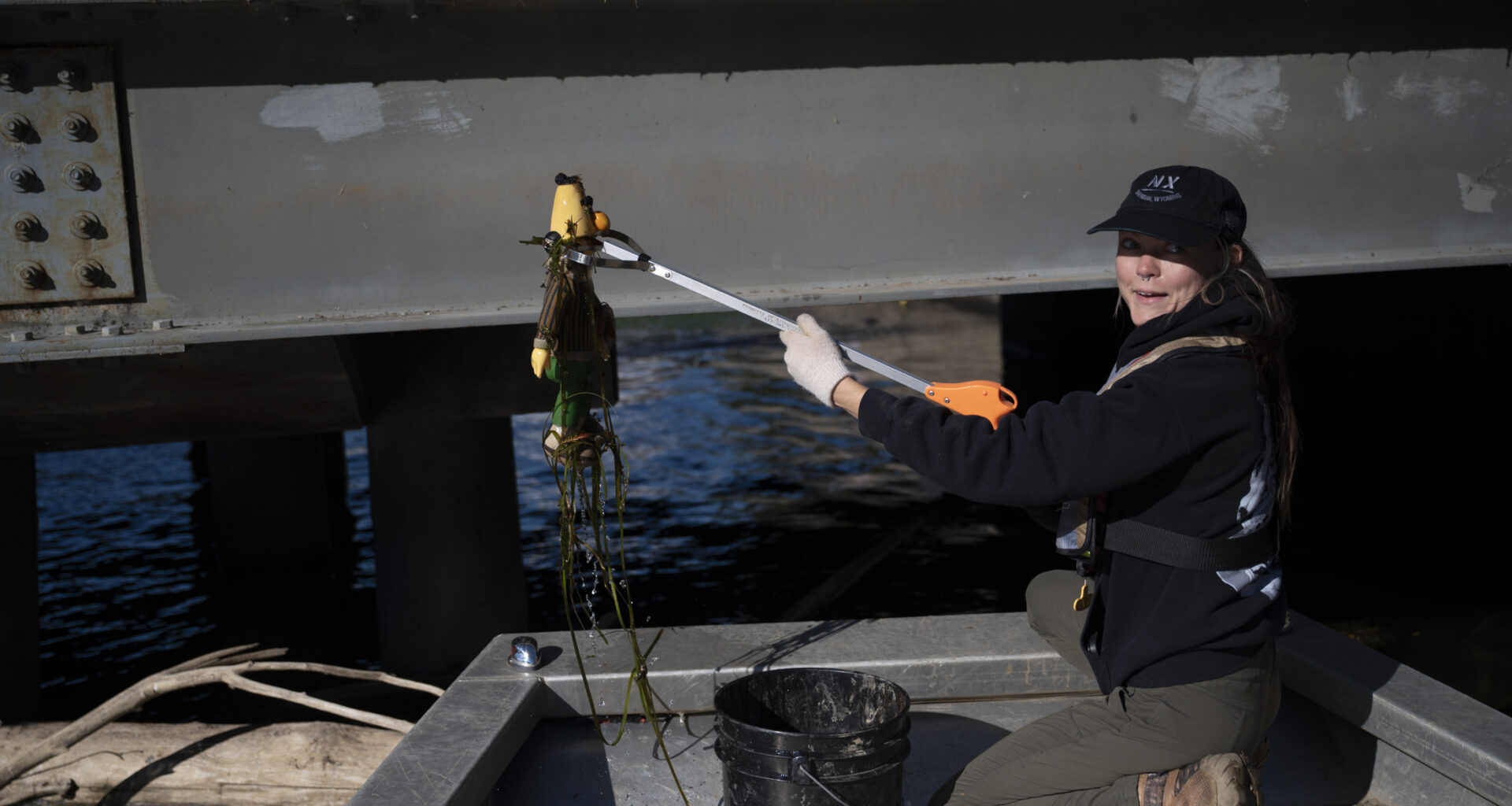On a recent weekday afternoon in the Lower Hill, Caily Grube, executive director of Allegheny CleanWays, crouched beside a crooked traffic sign at the corner of Washington Place and Centre Avenue, just downhill from PPG Paints Arena.
The sign had been wrong for years; its message no longer matched the stoplight above it, and the sandbags at its base had split open, scattering gravel and debris across the curb. Around it, trash had collected in the cracks: plastic bags, bottles, and the windblown remnants of game-day crowds.
She wasn’t there by chance. Hill District resident Reggie Howze, who has spent years quietly picking up litter on his own, had flagged the spot for her.
Together with a few volunteers, they spent about thirty minutes clearing the area, what Grube calls a “non-traditional, express cleanup” compared to the three-hour volunteer sessions that Allegheny CleanWays typically conducts.
That same roll-up-your-sleeves spirit is now rippling across the city. On Sept. 10, Grube stood on the North Shore alongside Mayor Ed Gainey, County Executive Sara Innamorato, and two dozen other guests to launch The Immaculate Collection, a sweeping effort to deep clean Pittsburgh ahead of the 2026 NFL Draft. The kickoff was equal parts spectacle and symbolism, with politicians and civic leaders tossing bags of trash into cans for the “Trash Toss Challenge,” a social media campaign designed to spread as fast as the ALS Ice Bucket Challenge once did.
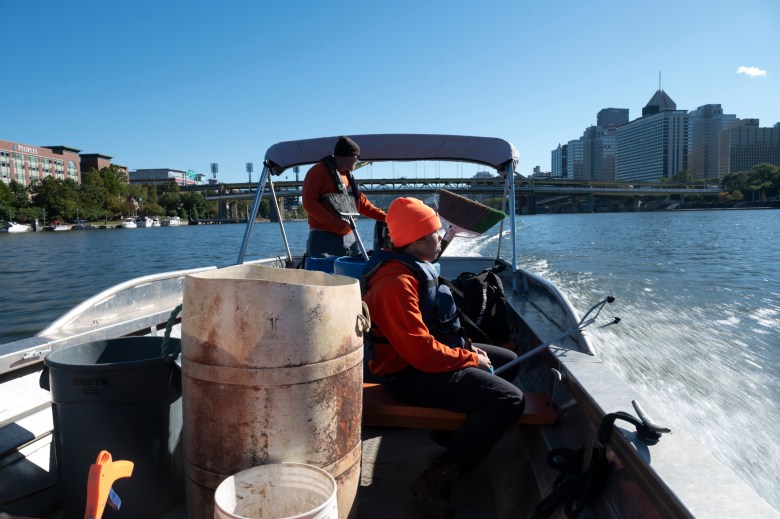 Allegheny CleanWays collects trash in the Allegheny River on Oct. 9, 2025. Credit: Mars Johnson / CP
Allegheny CleanWays collects trash in the Allegheny River on Oct. 9, 2025. Credit: Mars Johnson / CP
Now 80, Howze was born in the Hill District and grew up just blocks from playwright August Wilson, a childhood friend and classmate at St. Richard’s School. “I came back because I wanted the August Wilson House to be treated with the same respect as if he were a European playwright,” he says. “August deserves that, and so does the Hill.” His work keeping the Wilson house, the YMCA, and nearby corners clear of litter ties cultural heritage directly to today’s cleanup campaigns.
“It was a mess for years. Nobody took responsibility,” Howze says. “We cleaned it and it looked beautiful, but without maintenance, things don’t stay that way.”
He grew up in a time when Pittsburgh was considered the dirtiest city in America. “You could hang white clothes on the line in the morning, and by the afternoon they were brown with soot,” he recalls. That memory shapes his vision today: “My hope is that Pittsburgh rises from being the dirtiest city in America to the cleanest. Why not? Clean streets affect psychology, self-respect, emotions. It’s about how we see ourselves.”
Howze is one of the individuals Grube affectionately calls “litter lone wolves,” residents who take it upon themselves to care for their blocks long before any organized effort arrives. Others include Courtney Thompkins in McKeesport, who started neighborhood cleanups after noticing how her block had changed during the pandemic; Matt Indovina on the North Side with his group Urban Trails; Mary Lee Stenson in Shadyside; and Kelly Davis in Troy Hill.
“These are people who pick up trash all the time and don’t get attention for it,” Grube says. “I don’t think they always realize what they’re doing is excellent work. We want to stay connected with them, provide resources, and boost their efforts, as much or as little as they want.”
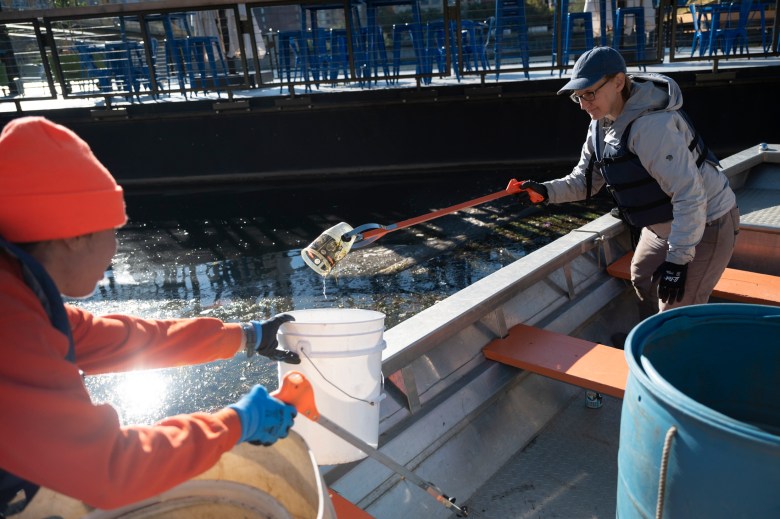 Stacy Marinos volunteers with Allegheny CleanWays on Oct. 9, 2025. Credit: Mars Johnson / CP
Stacy Marinos volunteers with Allegheny CleanWays on Oct. 9, 2025. Credit: Mars Johnson / CP
Grube believes that these everyday gestures, a neighbor stooping to grab a wrapper or a handful of volunteers hauling bags off a sidewalk, are the heart of something larger.
As the executive director of Allegheny CleanWays for the past two years, she brings a background in community social work and a master’s in community organizing to the task. To her, litter isn’t just an eyesore; it’s an entry point. “Litter is a really great conduit for creating community,” she says. “It doesn’t seem like it, but people come out together, do something tangible, see the difference, and then start thinking, what else can we do together?”
The Immaculate Collection nods to Franco Harris’ legendary Immaculate Reception, but the “Collection” part is literal: hundreds of bags of debris that volunteers and contractors plan to haul out of the city’s arteries. The campaign’s logo even shows Franco’s famous hands, frozen as if they’re about to intercept a pass.“I think it shows the agency we all have in our hands to solve this problem together,” Grube says.
Behind the spectacle lies a sprawling, layered plan. The Immaculate Collection calls for cleaning up to 100 miles of highways leading into and out of Downtown, routes like I-376, I-279, SR-28, SR-65, and SR-380, through an amplified Adopt-a-Highway effort. Crews will take boats out on the Allegheny, Monongahela, and Ohio Rivers to collect debris. About fifty neighborhood groups across Allegheny County are already activated to host their own cleanups. Organizers say this fall-and-spring blitz will serve as the foundation for sustained cleanups throughout 2026.
A collegiate competition led by Point Park University is slated for spring 2026, while a new High School Leadership Corps, formed with Pittsburgh Tomorrow and the Pittsburgh Promise, is tackling weeds and litter along the North Shore. The City of Pittsburgh’s Garbage Olympics, a competitive trash pickup, will return under the campaign’s banner. Allegheny CleanWays, spearheading the overall effort, is doubling its full-time crew to do weekly land and river cleanups throughout Allegheny County. Four days a week, Fridays through Mondays, volunteers gather for three-hour shifts on hillsides, alleys, waterways, and roadside edges.
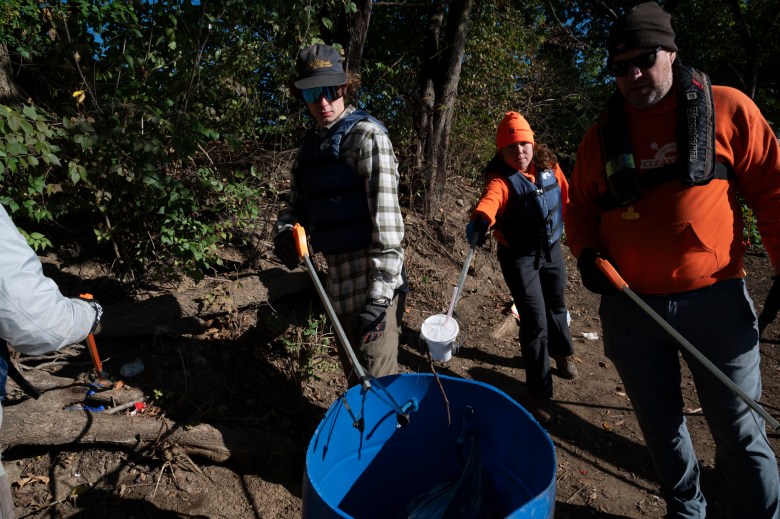 Alex Kirkpatrick, Kylie McCutcheon and Ben Halliburton dispose of trash along the Allegheny River on Oct. 9, 2025. Credit: Mars Johnson / CP
Alex Kirkpatrick, Kylie McCutcheon and Ben Halliburton dispose of trash along the Allegheny River on Oct. 9, 2025. Credit: Mars Johnson / CP
And beautification is built into the mix: flower baskets on key corridors, a new General Robinson Street garden, green-space activations in parks and trails, and downtown tree planting coordinated by the Western Pennsylvania Conservancy, the Pittsburgh Parks Conservancy, Friends of the Riverfront, and Riverlife.
“When it’s just you, the problem feels insurmountable,” Grube says. “But when you bring out 20 people, it suddenly feels possible.” Allegheny CleanWays has already hauled nearly 8 million pounds of trash, including more than 50,000 tires, in Allegheny County.
The mess is bigger than most Pittsburghers realize. A 2019 study by Keep Pennsylvania Beautiful, done with the state DEP and PennDOT, estimated over 500 million pieces of litter on Pennsylvania roadways.
Cigarette butts, plastic bottles, aluminum cans, and fast food packaging make up most of it, but volunteers also encounter prosthetic limbs, toys, and flat screen TVs. “There are a lot of misconceptions,” Grube says. “People think city workers will pick it up, which isn’t true. Or they think a cigarette butt will decompose, which it won’t. Trucks with unsecured loads? That’s where the couches and televisions come from.”
The campaign’s $1 million fundraising goal, seeded by the Eden Hall Foundation and supported by the Buhl Foundation, DBR & Co., Point Park University, and others, is devoted entirely to keeping up to 100 miles of highways on a regular maintenance schedule through PennDOT’s Sponsor-A-Highway program. That total funds two years of monthly cleanings (except in frozen months) at roughly $10,000 per mile per year, performed by PennDOT-approved contractors. (Neighborhood and river cleanups are funded separately through CleanWays’ own grants and donors.)
As of launch day, organizers said the effort had reached about one quarter of its $1 million target.
Still, the work is about more than cleaning up cigarette butts. “Litter isn’t just aesthetics,” Grube says. “It impacts crime, mental health, public health, community investment. It’s bad for civic pride.” To that end, the campaign includes an ongoing public education push aimed at changing behavior and reducing litter at its source.
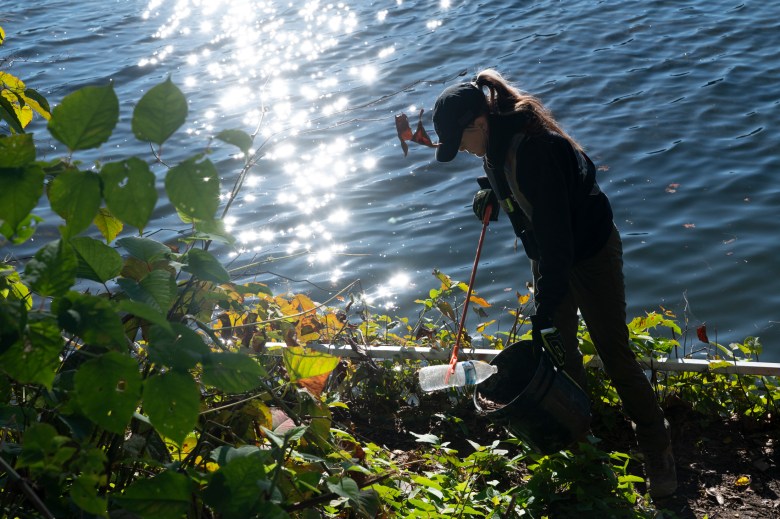 Water Crew Member Britt Menhart collects trash along the Allegheny River on Oct. 9, 2025. Credit: Mars Johnson / CP
Water Crew Member Britt Menhart collects trash along the Allegheny River on Oct. 9, 2025. Credit: Mars Johnson / CP
In McKeesport, Thompkins has carried that same determination into her own block. A 35-year-long resident, she has lived long enough to see the neighborhood change and still believes in its promise. “This is where I raised my children, where my grandchildren were born. The foundation is set here. I’ll leave my footprints here,” she says.
When Thompkins began noticing litter accumulating across the street from her house, a vacant lot owned by the school district, she reached out to the city for help. Soon, barrels were installed on the corners to give neighbors a place to toss trash. “People started respecting the surroundings,” she says. “It motivated others on the block to take notice.”
Her dream now is to turn that lot into a small green space with benches or even a bike path where kids can ride safely. “My goal is to make it safe, a place where kids can ride bikes, where people can sit and read,” she says. The progress is incremental, but Thompkins stays hopeful. “If I start, somebody else will start. If they see I’m serious, they’ll become serious.”
Even if the NFL Draft is the accelerant for the massive clean-up, the work is designed to run longer.
Grube insists The Immaculate Collection won’t disappear with the crowds. Relationships formed among government agencies, nonprofits, and corporations are meant to sustain cleanups for at least two years, with hopes that sponsors will keep funding beyond that. She points to models elsewhere, like the Poconos’ hotel occupancy tax that funds roadside maintenance, and says Pittsburgh might consider going a similar route in the future. In a city that prides itself on robotics, Grube wonders why no one has yet designed safer ways to clean highway medians. That too, might be what the future leads to. For now, though, the work is human.
“The eyes of the world will be on Pittsburgh during the Draft,” Grube says, “but the truth is: litter doesn’t just affect visitors’ first impressions. It affects how we see ourselves. The Draft gives us urgency, but the point is to sustain it long after April.”
This article appears in Oct. 15-21, 2025.
RELATED

